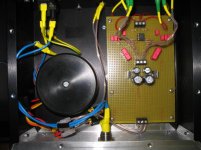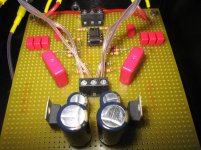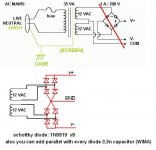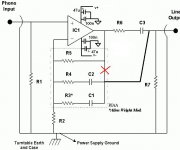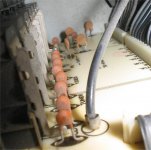I could be wrong here, but in the past I've only heard "hiss" referred to being from the opamps - kind of a rushing sound. Most around here have had hum problems, but not hissing.
Maybe you have the opamps set to ve high gain within the VSPS?
Only a shot in the dark, but maybe it might help
Fran
Maybe you have the opamps set to ve high gain within the VSPS?
Only a shot in the dark, but maybe it might help
Fran
MORE INFORMATION
My equipment:
Goldring GR-1 with Elektra capsule, without ground connection. The interconnect cable is not shielded.
Passive preamplifier diy, a symple alps potentiometer and a selector.
Two diy LM3886TF monoblocks from chipamp.com.
the vsps has 40db gain
I think it's probably a problem with rca ground or with the ground connection in the case.
Thanks
My equipment:
Goldring GR-1 with Elektra capsule, without ground connection. The interconnect cable is not shielded.
Passive preamplifier diy, a symple alps potentiometer and a selector.
Two diy LM3886TF monoblocks from chipamp.com.
the vsps has 40db gain
I think it's probably a problem with rca ground or with the ground connection in the case.
Thanks
May be your chasis grouding point. I saw 3 wire connected to the chasis. One should be your amp ground to chasis, 2nd might be from psu 0v, Where is the yellow wire from? Ac to chasis ground?
Try not to connect your 'AC ground to chasis' at the same point with your amp 'grouding to chasis'.
You can try to twist the RCA cable a bit if you suspect the hiss is from there.
Or you may read a little story of my troubleshotting at
http://skycoral.com/?p=49
Try not to connect your 'AC ground to chasis' at the same point with your amp 'grouding to chasis'.
You can try to twist the RCA cable a bit if you suspect the hiss is from there.
Or you may read a little story of my troubleshotting at
http://skycoral.com/?p=49
>juluska
Too long signal wires.
Too long signal pathes on pcb.
Transformer should be far away from phono pcb, specially from RIAA network.
Ground should be also short as possible. From PSU to phono board. From v stabilisation (phono board) to chassis thru 10-22R resistor.
Every RCA should be isolated from chassis!
Regards K
Too long signal wires.
Too long signal pathes on pcb.
Transformer should be far away from phono pcb, specially from RIAA network.
Ground should be also short as possible. From PSU to phono board. From v stabilisation (phono board) to chassis thru 10-22R resistor.
Every RCA should be isolated from chassis!
Regards K
distorted sound
Thanks. Changing the AC grounding point, twisting the cables and using shielded interconnect cables the high frequency noise is almost gone. I can only heard some mild hiss at very high volumes. But, after hours of hearing several lps I found that sound is worse that I espected, distorted and obscure. Is it possible that using metal film resistors 732k and 105k in RIAA eq can affect in that way the sound. I read carbon film resistors are better. Its true? And the long signal path in the protoboard, the distance between 1nF caps, or the big 4,7 uF coupling caps, can affect in that way the sound?
I'm considering to repeat the board. What are the best components to use and where can I buy them.
Thanks. Changing the AC grounding point, twisting the cables and using shielded interconnect cables the high frequency noise is almost gone. I can only heard some mild hiss at very high volumes. But, after hours of hearing several lps I found that sound is worse that I espected, distorted and obscure. Is it possible that using metal film resistors 732k and 105k in RIAA eq can affect in that way the sound. I read carbon film resistors are better. Its true? And the long signal path in the protoboard, the distance between 1nF caps, or the big 4,7 uF coupling caps, can affect in that way the sound?
I'm considering to repeat the board. What are the best components to use and where can I buy them.
Noise, noise, noise...
hello juluska: all your suspects may, could, can be, are...
RIAA correction is very sensitive and condensers should be polipropreline (or of high quality) and the resistors are all carbon and nothing metal... metal sounds metal. You can use nice Mcaps for the coupling or nice blackgates or other. Even if you didn't have mechanical problems (grounding, twisting the signalling wires etc...) I don't think you could enjoy the sound quality of this phono stage.
Only use the best quality and matched components for signal path manipulations. Plan once, be happy, or moderately content, and then improve on the design.
The problem with this design is that there are OpAmps therefore this phono stage can't, and probably will never sound Hifi. So the hissing will probably never go away... believe me, I have sensitive speakers and this causes me nightmares and hallucinating schizophrenia.
So I am working at a special solution to modify this design. I doubt that 47 Labs has used (all) OpAmps... If they have for sure they have stabilised them (or it) with the help of... (more to come after my little experiments).
Hope this helps,
MV
hello juluska: all your suspects may, could, can be, are...
RIAA correction is very sensitive and condensers should be polipropreline (or of high quality) and the resistors are all carbon and nothing metal... metal sounds metal. You can use nice Mcaps for the coupling or nice blackgates or other. Even if you didn't have mechanical problems (grounding, twisting the signalling wires etc...) I don't think you could enjoy the sound quality of this phono stage.
Only use the best quality and matched components for signal path manipulations. Plan once, be happy, or moderately content, and then improve on the design.
The problem with this design is that there are OpAmps therefore this phono stage can't, and probably will never sound Hifi. So the hissing will probably never go away... believe me, I have sensitive speakers and this causes me nightmares and hallucinating schizophrenia.
So I am working at a special solution to modify this design. I doubt that 47 Labs has used (all) OpAmps... If they have for sure they have stabilised them (or it) with the help of... (more to come after my little experiments).
Hope this helps,
MV
vsps second version
Following your suggentions, i repeated the board and the result is impresive, now it really sounds hi-fi as i espected, without hissing nor humming problems and very good sound. i think distance really influence in sound. the shorter signal path and smaller capacitors sonds better.
Thank you so much for your help and comments.
Following your suggentions, i repeated the board and the result is impresive, now it really sounds hi-fi as i espected, without hissing nor humming problems and very good sound. i think distance really influence in sound. the shorter signal path and smaller capacitors sonds better.
Thank you so much for your help and comments.
Attachments
a question
I observe that almost all the comercial amplifiers have capacitors and resistors the next to the rca inputs and outputs, like the photo. I have no idea of electronics but i think this is to eliminate high frequency noises and ground problems to avoid incompatibility with electronics. My diy gainclone monoblocks, passive preamplifier and VSPS had little problems with hum and hiss, but with shielded cables and proper place of components the problem is gone.
With comercial electronics hardly ever there are problems with hum and hiss and you can use the cheapest non shielded cable and you can place the components of any form without noise problems.
Are the input caps the way to achieve no noise amplifiers? if they eliminate noise, they also eliminate music?
thanks
I observe that almost all the comercial amplifiers have capacitors and resistors the next to the rca inputs and outputs, like the photo. I have no idea of electronics but i think this is to eliminate high frequency noises and ground problems to avoid incompatibility with electronics. My diy gainclone monoblocks, passive preamplifier and VSPS had little problems with hum and hiss, but with shielded cables and proper place of components the problem is gone.
With comercial electronics hardly ever there are problems with hum and hiss and you can use the cheapest non shielded cable and you can place the components of any form without noise problems.
Are the input caps the way to achieve no noise amplifiers? if they eliminate noise, they also eliminate music?
thanks
Attachments
Hum in phono preamps is often produced by ... turntable bad connections (inside - problems with ground).
If you want to check is your phono pre silent than: close input signal to ground and listen. If there is no hum then preamp is made correct, and source of hum is in the turntable.
About tricks: try it. Its cheap ... but worth sin and 100x money issued.
Regards K
If you want to check is your phono pre silent than: close input signal to ground and listen. If there is no hum then preamp is made correct, and source of hum is in the turntable.
About tricks: try it. Its cheap ... but worth sin and 100x money issued.
Regards K
Re: a question
The 471 indicates they are 470pF.
If the source equipment has an output impedance of 100ohms the RF attenuation filter will have F-3dB=3.4MHz.
If the source impedance is 1000ohms then the F-3dB = 340kHz and F-1dB = 170kHz. At this level of attenuation there is virtually no loss of audio signal.
However, the capacitance of the interconnect cables adds to the RF filter effect and pushes the F-1dB closer to the audio band. Cables contributing another 470pF would bring the filter frequency down by one octave.
the caps at the input RCA terminals are part of a low pass passive filter.juluska said:I observe that almost all the comercial amplifiers have capacitors and resistors the next to the rca inputs and outputs, like the photo.
The 471 indicates they are 470pF.
If the source equipment has an output impedance of 100ohms the RF attenuation filter will have F-3dB=3.4MHz.
If the source impedance is 1000ohms then the F-3dB = 340kHz and F-1dB = 170kHz. At this level of attenuation there is virtually no loss of audio signal.
However, the capacitance of the interconnect cables adds to the RF filter effect and pushes the F-1dB closer to the audio band. Cables contributing another 470pF would bring the filter frequency down by one octave.
Well Ive finally built the PC and have been chasing a hum for a couple weeks. It is built as shown on RJMs site, using one Plitron 12-0-12 transformer and one bridge rectifier. After tearing the PS chassis apart to see if I had managed to muck up the grounding, I found that the DC voltage to the boards was only 12.4 VDC.
Firstly, can the low voltage to the regulators cause hum. Second, what is going on with the voltage. Ive checked all my wiring and am at a lost as to the problem. The unloaded AC into the bridge is 13.7. The DC out is +/- 12.5v. What the heck am I overlooking? What happened to my 1.4X AC voltage?
amt
Firstly, can the low voltage to the regulators cause hum. Second, what is going on with the voltage. Ive checked all my wiring and am at a lost as to the problem. The unloaded AC into the bridge is 13.7. The DC out is +/- 12.5v. What the heck am I overlooking? What happened to my 1.4X AC voltage?
amt
You may well have 2 unrelated issues here.
First sort the voltage. Disconnect from the board and load with a small load - say 250mA. something like a 60 - 100R resistor should load it enough. IIRC, my unloaded voltage was in the region of 17V from a 12V transformer (raw DC after the bridge before onboard regulation).
Then if thats alright reconnect your boards and see the + and - voltage before and after regulation. Check for shorts etc etc etc.
Given the history of these modules, your hum is most likely to be from input, output cables or the turntable.
Fran
First sort the voltage. Disconnect from the board and load with a small load - say 250mA. something like a 60 - 100R resistor should load it enough. IIRC, my unloaded voltage was in the region of 17V from a 12V transformer (raw DC after the bridge before onboard regulation).
Then if thats alright reconnect your boards and see the + and - voltage before and after regulation. Check for shorts etc etc etc.
Given the history of these modules, your hum is most likely to be from input, output cables or the turntable.
Fran
Ok, I didnt have an appropriate resistors on hand so I popped in some 1000uf caps instead. The DC now reads +/- 19VDC which is great. I feel like an idiot but Im sure that in the past, several PSs I tested had higher DC output just out of the bridge. Oh well, looks like loading the supply is manditory to check the output.
Now the hum problem: Ive been using a '80s Linn LP12 with a Benz Ref3 and cant get the hum out. This is my friends TT. I was able to remove most of it by shorting the input grounds, but its still there. I also took the Linn to a friends and tried his Sonographe w/MC though the PC and a Carver preamp and no hum. The Linn hummed with the PC but NOT when using the Carvers MC phono. ???
I have replaced the stock Linn interconnects with Cardas shielded and no change. I did continuity checks on the arm wire and all seem fine. Also, the Valhalla board was "repaired" at some point since several components have been replaced (the originals looked to have blackened the PCB with their failure)
So, can there be an incompatabiliy with the Benz, the Linn grounding scheme, arm wiring or a flaw in the Valhalla PCB that might be responsible?
amt
Now the hum problem: Ive been using a '80s Linn LP12 with a Benz Ref3 and cant get the hum out. This is my friends TT. I was able to remove most of it by shorting the input grounds, but its still there. I also took the Linn to a friends and tried his Sonographe w/MC though the PC and a Carver preamp and no hum. The Linn hummed with the PC but NOT when using the Carvers MC phono. ???
I have replaced the stock Linn interconnects with Cardas shielded and no change. I did continuity checks on the arm wire and all seem fine. Also, the Valhalla board was "repaired" at some point since several components have been replaced (the originals looked to have blackened the PCB with their failure)
So, can there be an incompatabiliy with the Benz, the Linn grounding scheme, arm wiring or a flaw in the Valhalla PCB that might be responsible?
amt
OK, the hum problem is sticky. I used a Linn LP12 in different setups (cables, cartridges, supplies) with the phonclone and got hum problems - but now they are solved.
At first: The power supply and bypass capacitors have nearly no impact to the hum, it remains to the standard Phonoclone circuit even if you are using battery supply.
At second: The valhalla has no impact - I disconnected the board completely, and the hum remains.
Now to the solutions: The Benz Ref 3 has (as the Linns Akiva, Arkiv, Troika, Klyde) a low impedance at about 4 - 5 Ohms. You have to adjust R1 to 5 Ohms (or even less) at first. This brought a huge improvement.
The second problem is the linn cable: I suppose you are using the standard grey linn LP12 cable. It is not a bad cable , but is for some reason poor in "generating" hum (maybe the cardas is the same class ...) - in particular in the Phonoclone circuit. I tried some different material from van den Hul and Oehlbach an get rid of the hum.
At third: Lower the R2 to set the gain of the first stage. A value of 300 Ohms is appropriate - even if not recommended.
At fourth: Use the capacitor of 220p cross OP inputs. This will solve the at least most inference and hum problems - however it will affect the sound a little (I used a switched capacitor for that reason). This should be done if no other point works ...
At last: Always connect the grounding cable from the LP12 as recommended to the phonoclone circuit.
At first: The power supply and bypass capacitors have nearly no impact to the hum, it remains to the standard Phonoclone circuit even if you are using battery supply.
At second: The valhalla has no impact - I disconnected the board completely, and the hum remains.
Now to the solutions: The Benz Ref 3 has (as the Linns Akiva, Arkiv, Troika, Klyde) a low impedance at about 4 - 5 Ohms. You have to adjust R1 to 5 Ohms (or even less) at first. This brought a huge improvement.
The second problem is the linn cable: I suppose you are using the standard grey linn LP12 cable. It is not a bad cable , but is for some reason poor in "generating" hum (maybe the cardas is the same class ...) - in particular in the Phonoclone circuit. I tried some different material from van den Hul and Oehlbach an get rid of the hum.
At third: Lower the R2 to set the gain of the first stage. A value of 300 Ohms is appropriate - even if not recommended.
At fourth: Use the capacitor of 220p cross OP inputs. This will solve the at least most inference and hum problems - however it will affect the sound a little (I used a switched capacitor for that reason). This should be done if no other point works ...
At last: Always connect the grounding cable from the LP12 as recommended to the phonoclone circuit.
- Home
- Source & Line
- Analogue Source
- The Phonoclone and VSPS PCB Help Desk
